New tools improve farm nutrient and water management

EU-funded researchers have developed new mapping tools and services to help farmers better manage the application of nutrients and water to their fields and promote sustainable agriculture.
Intensive crop production helps provide a secure supply of affordable food, but this consumes vast amounts of water and pollutes the soil. More sustainable crop management and production methods are urgently needed to continue feeding a growing population without compromising the environment or public health.
Sustainable agriculture means optimising the yield and income of farms with a minimum of inputs like irrigation water, nutrients, energy, pesticides and herbicides. The FATIMA project addressed these challenges by developing operational large-scale precision farming tools and creating a dedicated stakeholder community.
Precision farming for greater efficiency
Researchers worked with farmers, managers and decision makers in the agribusiness sector, developing a series of maps ranging from the farm to river-basin scale. The project developed precision farming tools using Earth Observation data and wireless sensor networks tailored to local needs and deployed them on the ground.
"We created high-resolution maps for determining nutrient and water requirements, so farmers can fine-tune the amount of inputs they actually need to avoid over-fertilisation and save water," says project coordinator Prof. Alfonso Calera. In arid La Mancha, Spain, for example, partners focused on ensuring efficient water and fertiliser use, while in Marchfeld, Austria a key concern was water quality problems due to intensive agriculture. Thessaly in Greece has been declared a vulnerable region due to groundwater nitrate pollution.
An online geographical information system (or webGIS) provides stakeholders with access to the online tools. Comprehensive guides for crop monitoring, management zoning and nitrogen balance can also be downloaded. "The FATIMA webGIS is a platform with a dedicated app, AgriSat, for mobile phone, where SMEs can reach potential customers with new mapping tools, and farmers can find solutions tailored to their needs," explains Prof. Calera.
A further interesting development is the farm-level cost benefit analysis, a complementary tool that helps farmers decide which technology to adopt or service to buy. The tool enables farmers to assess farm profitability on the one hand, and the economic feasibility of a specific FATIMA service on the other.
New technologies adopted
The developed multisensor constellation built by the COPERNICUS satellites Sentinel 2a and 2B, complementary with Landsat 8, offers a unique tool for providing 'intelligence' for implementing operational Variable Rate Fertilization. Its main characteristics include high temporal repetitiveness, which makes it possible to follow the vegetation during the critical stage revealing the soil/water/nitrogen interactions. In addition, its high spatial resolution (10 m) is adapted to the spatialised application scale of fertilisers and it has an interesting spectral content for the characterisation of the nitrogenous status of plants.
FATIMA also explored farmers' preferences and willingness to adopt new mapping technologies in the short-term, as well new production methods over the longer term. According to Prof. Calera: "We conducted surveys and focus groups on seven pilot areas and analysed results relating to both short-term and long-term strategies."
This led to the identification of specific conditions deemed essential for FATIMA services to flourish following project completion. "These include successfully demonstrating and validating tools by core users, achieving a critical mass of committed users as well as recognition and support by policy and decision makers," claims Prof. Calera.
Ultimately, precision agriculture – optimising input management according to nutrient and water requirements as championed by FATIMA – is just the first step towards more sustainable agriculture. "In the long term, changes in agricultural practices such as crop rotation, conservation agriculture and transformation to more sustainable production systems are also required," Prof. Calera points out.
Provided by CORDIS




















